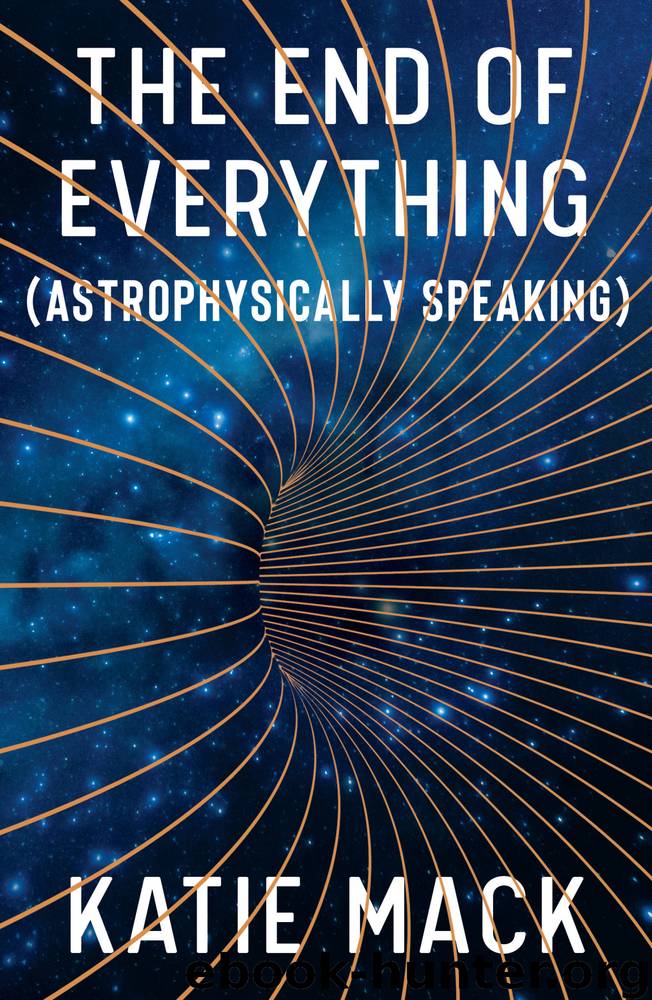The End of Everything: (Astrophysically Speaking) by Katie Mack

Author:Katie Mack
Language: eng
Format: epub
Publisher: Scribner
Published: 2020-08-03T23:00:00+00:00
STAR LIGHT THERMONUCLEAR BRIGHT
But this book is about destruction, and I would be remiss if I glossed over Type Ia supernovae as just “a kind of exploding star.” A white dwarf star, the kind of star our Sun is fated to eventually become, is itself a marvel of stellar evolution. And when one explodes, it does so by undergoing an all-out full-body thermonuclear detonation that outshines its entire galaxy.
If you are any kind of star, no matter what stage you are at in your life cycle, your existence depends on a careful balancing act between the pressure produced in your core and the gravity of the material you’re made of. (We call this “hydrostatic equilibrium” but it really just comes down to the idea that the push out has to be equal to the pull in for a star to neither blow up nor collapse.) Most of the time, a star creates outward pressure by doing fusion reactions in its core—pressing nuclei together so tightly that they fuse and become a heavier kind of atom. For all the lightest elements, fusing them together produces radiation, and that radiation is the pressure that holds the star up against collapse.
For a star like the Sun, the outward pressure is provided by the fusion of hydrogen into helium. Most stars are, in fact, just giant helium factories, taking the abundant hydrogen in the universe and sticking it together, countless billions of times per second.
Let’s consider the Sun, in particular, for sentimental reasons.
Right now, the Sun is happily burning hydrogen, creating a surplus of helium in its core and causing the temperature and pressure to change over time as the hydrogen-helium balance tips. Because the efficiency of the factory depends on both temperature and pressure, the energy output and size of the Sun will change over time—most noticeably, the Sun will get a little bit more radiant and a little bit biggerX over the next few million years.
At somewhere around a billion years, we get to the part where we’re all fried. But even after the Earth is well on its way to becoming a charred lifeless rock, the Sun has a long way to go yet. As that increased heat is incinerating the inner planets (Mercury and Venus) and evaporating all the oceans off the Earth, so much hydrogen will be burned off that there will only be a shell of hydrogen burning around the central helium-filled core. The core then gets hot enough to start fusing helium into oxygen and carbon and turns the Sun into a huge bloated red giant star. When the Sun eventually runs out of all hydrogen to fuse, a few billion years into its red giant phase, it’ll begin its death throes in earnest. The core will start filling with oxygen, then carbon, the production fueled by the squeezing of the core by the gravity of the rest of the star. In the end, though, after the Sun has swelled to engulf the orbit of Venus and
Download
This site does not store any files on its server. We only index and link to content provided by other sites. Please contact the content providers to delete copyright contents if any and email us, we'll remove relevant links or contents immediately.
| Aeronautics & Astronautics | Astronomy |
| Astrophysics & Space Science | Comets, Meteors & Asteroids |
| Cosmology | Mars |
| Solar System | Star-Gazing |
| Telescopes | UFOs |
Turbulence by E. J. Noyes(7037)
Tools of Titans by Timothy Ferriss(6944)
Astrophysics for People in a Hurry by Neil DeGrasse Tyson(4617)
Room 212 by Kate Stewart(4102)
Pale Blue Dot by Carl Sagan(4001)
The David Icke Guide to the Global Conspiracy (and how to end it) by David Icke(3880)
Secrets of Antigravity Propulsion: Tesla, UFOs, and Classified Aerospace Technology by Ph.D. Paul A. Laviolette(3438)
Apollo 8 by Jeffrey Kluger(3199)
Losing the Nobel Prize by Brian Keating(3186)
A Journey Through Divination and Astronomy by Publishing Pottermore(3051)
Goodbye Paradise(2957)
COSMOS by Carl Sagan(2949)
Brief Answers to the Big Questions by Stephen Hawking(2874)
How to Read Water: Clues and Patterns from Puddles to the Sea (Natural Navigation) by Tristan Gooley(2851)
The Five People You Meet in Heaven by Mitch Albom(2839)
The Order of Time by Carlo Rovelli(2713)
How to Read Nature by Tristan Gooley(2662)
A Brief History of Time by Stephen Hawking(2473)
Aliens by Jim Al-Khalili(2381)
